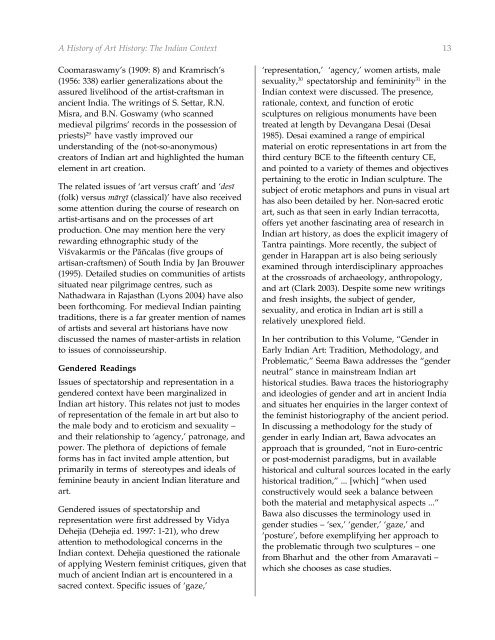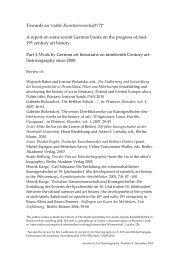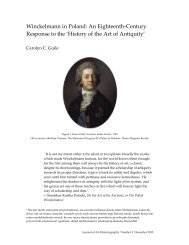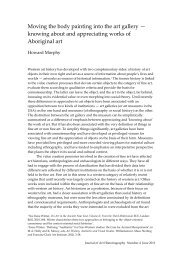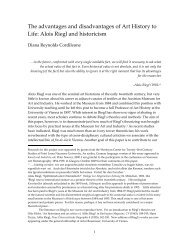Indian Art history.cdr - Journal of Art Historiography
Indian Art history.cdr - Journal of Art Historiography
Indian Art history.cdr - Journal of Art Historiography
Create successful ePaper yourself
Turn your PDF publications into a flip-book with our unique Google optimized e-Paper software.
A History <strong>of</strong> <strong>Art</strong> History: The <strong>Indian</strong> Context 13<br />
Coomaraswamy’s (1909: 8) and Kramrisch’s<br />
(1956: 338) earlier generalizations about the<br />
assured livelihood <strong>of</strong> the artist-craftsman in<br />
ancient India. The writings <strong>of</strong> S. Settar, R.N.<br />
Misra, and B.N. Goswamy (who scanned<br />
medieval pilgrims’ records in the possession <strong>of</strong><br />
priests) 29 have vastly improved our<br />
understanding <strong>of</strong> the (not-so-anonymous)<br />
creators <strong>of</strong> <strong>Indian</strong> art and highlighted the human<br />
element in art creation.<br />
The related issues <strong>of</strong> ‘art versus craft’ and ‘desé<br />
(folk) versus märgé (classical)’ have also received<br />
some attention during the course <strong>of</strong> research on<br />
artist-artisans and on the processes <strong>of</strong> art<br />
production. One may mention here the very<br />
rewarding ethnographic study <strong>of</strong> the<br />
Viçvakarmés or the Päïcalas (five groups <strong>of</strong><br />
artisan-craftsmen) <strong>of</strong> South India by Jan Brouwer<br />
(1995). Detailed studies on communities <strong>of</strong> artists<br />
situated near pilgrimage centres, such as<br />
Nathadwara in Rajasthan (Lyons 2004) have also<br />
been forthcoming. For medieval <strong>Indian</strong> painting<br />
traditions, there is a far greater mention <strong>of</strong> names<br />
<strong>of</strong> artists and several art historians have now<br />
discussed the names <strong>of</strong> master-artists in relation<br />
to issues <strong>of</strong> connoisseurship.<br />
Gendered Readings<br />
Issues <strong>of</strong> spectatorship and representation in a<br />
gendered context have been marginalized in<br />
<strong>Indian</strong> art <strong>history</strong>. This relates not just to modes<br />
<strong>of</strong> representation <strong>of</strong> the female in art but also to<br />
the male body and to eroticism and sexuality –<br />
and their relationship to ‘agency,’ patronage, and<br />
power. The plethora <strong>of</strong> depictions <strong>of</strong> female<br />
forms has in fact invited ample attention, but<br />
primarily in terms <strong>of</strong> stereotypes and ideals <strong>of</strong><br />
feminine beauty in ancient <strong>Indian</strong> literature and<br />
art.<br />
Gendered issues <strong>of</strong> spectatorship and<br />
representation were first addressed by Vidya<br />
Dehejia (Dehejia ed. 1997: 1-21), who drew<br />
attention to methodological concerns in the<br />
<strong>Indian</strong> context. Dehejia questioned the rationale<br />
<strong>of</strong> applying Western feminist critiques, given that<br />
much <strong>of</strong> ancient <strong>Indian</strong> art is encountered in a<br />
sacred context. Specific issues <strong>of</strong> ‘gaze,’<br />
‘representation,’ ‘agency,’ women artists, male<br />
sexuality, 30 spectatorship and femininity 31 in the<br />
<strong>Indian</strong> context were discussed. The presence,<br />
rationale, context, and function <strong>of</strong> erotic<br />
sculptures on religious monuments have been<br />
treated at length by Devangana Desai (Desai<br />
1985). Desai examined a range <strong>of</strong> empirical<br />
material on erotic representations in art from the<br />
third century BCE to the fifteenth century CE,<br />
and pointed to a variety <strong>of</strong> themes and objectives<br />
pertaining to the erotic in <strong>Indian</strong> sculpture. The<br />
subject <strong>of</strong> erotic metaphors and puns in visual art<br />
has also been detailed by her. Non-sacred erotic<br />
art, such as that seen in early <strong>Indian</strong> terracotta,<br />
<strong>of</strong>fers yet another fascinating area <strong>of</strong> research in<br />
<strong>Indian</strong> art <strong>history</strong>, as does the explicit imagery <strong>of</strong><br />
Tantra paintings. More recently, the subject <strong>of</strong><br />
gender in Harappan art is also being seriously<br />
examined through interdisciplinary approaches<br />
at the crossroads <strong>of</strong> archaeology, anthropology,<br />
and art (Clark 2003). Despite some new writings<br />
and fresh insights, the subject <strong>of</strong> gender,<br />
sexuality, and erotica in <strong>Indian</strong> art is still a<br />
relatively unexplored field.<br />
In her contribution to this Volume, “Gender in<br />
Early <strong>Indian</strong> <strong>Art</strong>: Tradition, Methodology, and<br />
Problematic,” Seema Bawa addresses the “gender<br />
neutral” stance in mainstream <strong>Indian</strong> art<br />
historical studies. Bawa traces the historiography<br />
and ideologies <strong>of</strong> gender and art in ancient India<br />
and situates her enquiries in the larger context <strong>of</strong><br />
the feminist historiography <strong>of</strong> the ancient period.<br />
In discussing a methodology for the study <strong>of</strong><br />
gender in early <strong>Indian</strong> art, Bawa advocates an<br />
approach that is grounded, “not in Euro-centric<br />
or post-modernist paradigms, but in available<br />
historical and cultural sources located in the early<br />
historical tradition,” ... [which] “when used<br />
constructively would seek a balance between<br />
both the material and metaphysical aspects ...”<br />
Bawa also discusses the terminology used in<br />
gender studies – ‘sex,’ ‘gender,’ ‘gaze,’ and<br />
‘posture’, before exemplifying her approach to<br />
the problematic through two sculptures – one<br />
from Bharhut and the other from Amaravati –<br />
which she chooses as case studies.


